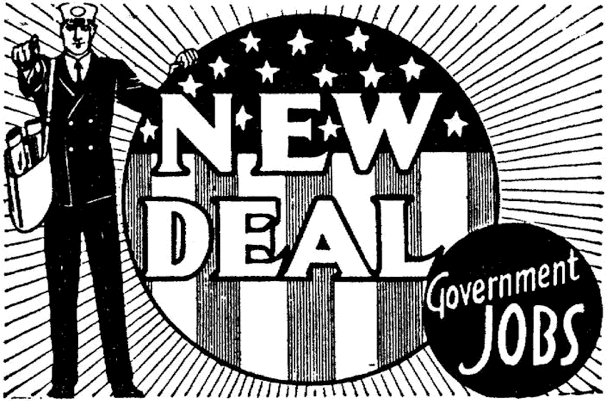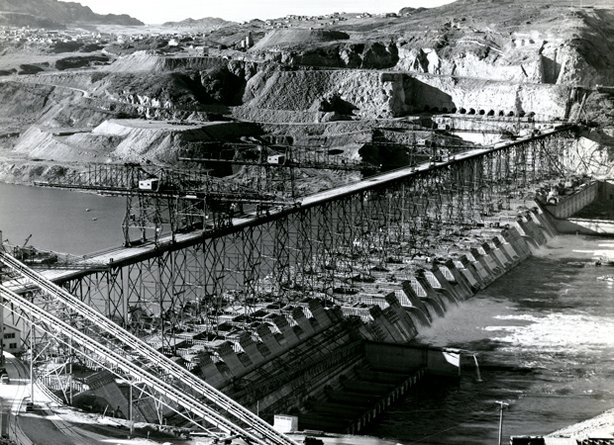 |
| U.S. New Deal |
In his acceptance speech at the 1932 Democratic National Convention, Franklin Delano Roosevelt pledged "a new deal for the American people." The term was subsequently used to describe the spate of government programs and reform laws enacted during the first months of Roosevelt's presidency in 1933; 15 major bills impacting industry, agriculture, banking, and the unemployed were passed during Roosevelt's first hundred days in office to combat the crisis of the Great Depression.
Another round of legislation, known as the Second New Deal, was adopted in 1935. The various New Deal programs marked an unprecedented effort by the U.S. federal government to stabilize the country and improve the daily lives of Americans.
Among the most significant legislation was the National Industrial Recovery Act (NIRA) of 1933. The act attempted to stabilize the economy through careful planning, striking a balance between supply and demand.
  |
A primary cause of the depression had been the disparity between industrial productivity and consumer purchasing power: While manufacturing output, spurred by rapid technological advances, increased 50 percent during the 1920s, per capita income rose much more slowly at 9 percent, and the result was a precariously inefficient, wasteful national economy. The Roosevelt administration responded by calling for fair competitive practices, production quotas, price controls, and increased wages.
To gain the crucial support of business leaders, the administration suspended antitrust laws and permitted major industries and trade associations to govern themselves by establishing compacts under the auspices of the National Recovery Administration (NRA). To gain the support of labor, the administration enforced a minimum wage, a 40hour workweek, and the outlawing of child labor.
Agriculture
The Roosevelt administration similarly sought to rationalize the agricultural sector of the economy through the Agricultural Adjustment Administration (AAA). Even during the 1920s, American farmers were faced with overproduction, low crop prices, and a heavy debt load, and their plight dramatically worsened during the depression years.
The nation's net farm income, worth $6.1 billion in 1929, plummeted to $2 billion in 1932. Sheriff's sales were commonplace in rural areas, as farmers could not meet their mortgages; on a single day in 1932 in Mississippi, 25 percent of the land in the state was foreclosed. The AAA made payments to farmers to reduce acreage and eliminate livestock.
 |
| National Recovery Administration (NRA) |
While the New Deal attempted to address structural problems in the American economy, there was a pressing need for immediate relief. At the time of Roosevelt's inauguration in 1933, 25 percent of the workforce was unemployed.
In response, Congress appropriated $500 million to form the Federal Emergency Relief Administration (FERA), which disbursed emergency grants to state and local agencies for direct distribution to the poor.
In addition, the administration created the Civil Works Administration, a temporary organization that provided small construction and repair jobs for 4 million workers during the winter of 1933–34.
As part of the National Industrial Recovery Act, the Public Works Administration (PWA) was established to sponsor large-scale public works enabling steady employment. Among other projects, the PWA completed the Grand Coulee Dam, the Triborough Bridge in New York City, and hundreds of school buildings.
The New Deal produced a hodgepodge of other programs reflecting the administration's ad hoc experimentation in the face of crisis. The Civilian Conservation Corps, one of the president's pet projects, employed approximately 3 million young unmarried men on environmental projects, such as building firebreaks and campgrounds in national parks.
 |
| Building of Grand Coulee Dam |
The Tennessee Valley Authority (TVA), another project of special interest to Roosevelt, was an effort to bring hydroelectric power to the underdeveloped Tennessee River region, where only 2 percent of farms had electricity in 1932. The TVA built 30 dams to reclaim floodplains and more than a dozen power plants to generate cheap electricity.
In 1934 Congress passed the Securities and Exchange Act, which successfully reined in some of the speculative stock market practices that had contributed to the crash in 1929. The New Deal became involved in cultural efforts such as Federal Project One, a relief program established in 1935 to provide work for writers, actors, musicians, and artists.
Roosevelt's administration made little effort to aid minority groups and had a particularly poor record on African-American civil rights, as the president hesitated to offend influential southern Democratic congressmen. Nevertheless, the Indian Reorganization Act of 1934 allowed Native Americans increased autonomy on their reservations.
   |
American Liberty League
The most serious political challenge to the New Deal was mounted between 1934 and 1936. During those years, prominent conservative businessmen created a well-publicized lobby group, the American Liberty League, to denounce what they saw as the New Deal commitment to class warfare and incipient communism.
The populist Louisiana governor Huey Long accused the Roosevelt administration of placating wealthy businessmen, advocating a "Share the Wealth" program that would force the rich to pay for social programs for the poor. A mass movement led by a retired doctor, Francis Townsend, supported the creation of an "Old Age Revolving Pension," by which every American over the age of 60 would receive a monthly federal payment.
The Supreme Court dealt the New Deal a blow through several unfavorable decisions; the most significant, Schechter Poultry Corp v. United States, ruled unanimously that the National Recovery Administration was unconstitutional.
Always a nimble politician, the president sought to defuse populist discontent by offering moderate versions of the favored programs of his most prominent critics. Historians regard the Second New Deal in 1935 as more directly committed to assisting the unemployed, industrial workers, and the elderly than the First New Deal of 1933–34.
The administration instituted the Works Progress Administration (WPA), a considerable expansion of earlier work relief programs that eventually employed more than 8 million people. The National Labor Relations Act extended the labor rights of the NIRA by establishing a National Labor Relations Board to arbitrate collective bargaining.
This guaranteed unions increased protections and served to systematize relations between massproduction workers and their employers. Perhaps the most far-reaching legislation of the New Deal era, the Social Security Act established a "safety net" for Americans, providing not only an old-age pension but also unemployment insurance and federal assistance for needy, dependent children and the disabled.
Despite its enormously ambitious agenda, the New Deal did not produce the hoped-for economic recovery. The gross national product slowly increased during Roosevelt's first term in office, but in 1937 the country suffered through a significant downturn known as the "Roosevelt Recession," when business profits dropped by 80 percent.
Farm prices increased by 50 percent between 1932 and 1936, but much of the scarcity in agriculture was brought on by an environmentally devastating dust bowl that engulfed the Plains states. The problem of unemployment remained intractable.
Unemployment statistics looked much the same throughout the New Deal era: 21.7 percent of American workers were unemployed in 1934, 20.1 percent in 1935, and 19.0 percent in 1938. The general economic mobilization during World War II—and not New Deal policy—finally enabled the country to recover from the Great Depression.
Historians have pointed to several problems with the implementation of New Deal programs that impeded their effectiveness. For example, the National Recovery Administration struggled with the unwieldy task of administering competition and production codes for more than 550 separate industries.
Small businessmen complained about having no voice in the NRA, and fewer than 10 percent of the code authorities included labor representatives. Large businesses sought to protect their own self-interest and so engaged in pricefixing measures, instituting rules that forbade selling "below cost." Consumers were thus denied the chance to buy inexpensive goods.
The benefits of the Agricultural Adjustment Administration were also unevenly distributed, favoring rural landowners rather than tenant farmers and sharecroppers, who constituted onefourth of the population in the South during the 1930s. A widespread practice by landowners was to evict their tenants, take that land out of production, and collect payment from the AAA.
The president expressed ambivalence about his administration's relief efforts. Although these programs were established with the idea that work relief could restore a sense of dignity among the unemployed, Roosevelt was concerned that relief would become "a habit with the country."
Historians have debated the legacy of the New Deal. During the 1950s, many viewed the New Deal as a triumph for liberalism and democracy. In the 1960s, revisionist historians argued that the New Deal consistently pushed an agenda of "corporate liberalism."
Their analysis held that the depression decade offered an unprecedented opportunity to substantively change the American economic system. Instead, the Roosevelt administration, influenced by corporate and financial elites, used strategic moderate reforms to defuse popular discontent, thereby safeguarding capitalism.
More recent historians have countered that Roosevelt had no mandate to restructure American society through radical reform. They point to the inherent conservatism of the American people during the 1930s. Corporate interests remained hostile to the New Deal even after it introduced banking and securities reforms that effectively stabilized the financial system.
Many of Roosevelt's congressional allies, particularly western and southern senators, were only willing to support the emergency measures of the First New Deal. They were deeply suspicious of expanding federal bureaucratic power and fought against nonemergency reforms.
The New Deal established the template for federal activism—but the Roosevelt administration also understood that this activism should be tempered by the desires of constituents. The New Deal philosophy insisted that Americans had the right to basic welfare protections, initiating "safety net" policies that lasted through the 20th century. Primarily, however, the New Deal was an expedient, improvisatory response to the emergency conditions of the Great Depression.